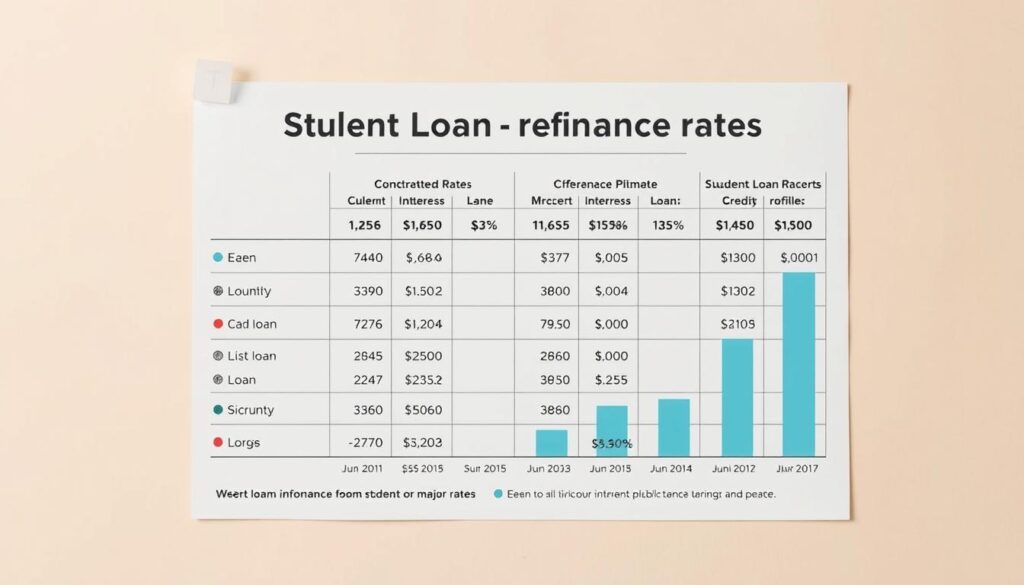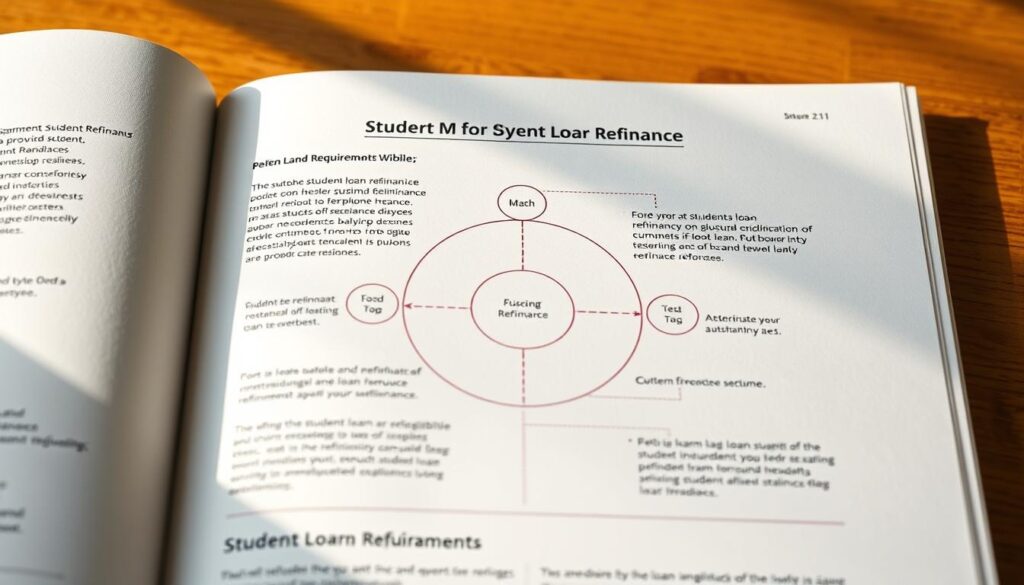Unlock Savings with Our Student Loan Refinance Guide
Did you know millions of Americans face the challenge of multiple student loans? Each loan has its own interest rate and repayment plan. This can cause a lot of financial stress and make it hard to manage debt.
Refinancing can make things easier. It combines all these loans into one manageable payment with a lower interest rate. This way, you can save money on interest and lighten your financial load.
Our guide will help you understand how to refinance your loans. We’ll show you the benefits and the best options out there. Our goal is to give you the knowledge to make smart choices about your financial future.
Key Takeaways
- Simplified loan repayment through consolidation
- Potential savings on interest with a lower rate
- A single, manageable monthly payment
- Guidance on choosing the best refinance options
- Empowerment through knowledge for better financial decisions
Understanding Student Loan Refinance
Understanding student loan refinance is key to making smart financial choices. When you refinance, you get a new loan to pay off old debt. The main goal is to get a better interest rate or better terms.
What is Student Loan Refinance?
Refinancing means swapping your old loans for a new one with a lower interest rate. This can make your finances simpler by combining loans into one. For more info, check out our beginner’s guide to refinancing.
Refinancing can save you money on interest over time. For example, if you have high-interest loans, a lower rate can cut down what you pay.
Benefits of Refinancing Student Loans
Refinancing has many benefits, like lower monthly payments and reduced interest rates. It also lets you switch to a fixed rate from a variable one. A lower rate means you save money over the loan’s life. Plus, it simplifies managing your debt by combining loans into one.
- Lower Monthly Payments: A longer repayment period or a lower rate can lower your monthly payments.
- Simplified Finances: Combining loans makes managing your debt easier.
- Potential Savings: A lower interest rate can save you a lot of money over time.
It’s crucial to look at the new loan’s terms to see if they fit your financial goals. Think about the interest rate, repayment terms, and any fees before deciding.
Eligibility Criteria for Refinancing
To refinance your student loans, you must meet certain requirements. These include a good credit score and stable income. Lenders check these to see if you can pay back the loan.
Who Qualifies for Student Loan Refinance?
To refinance your student loans, you need a good credit history. A FICO score of at least 670 is usually needed for the best rates. Lenders see borrowers with high scores as less risky. They also look at your income and debt-to-income ratio to make sure you can handle monthly payments.
Here are the main things lenders look at:
- Credit score: A higher score means better chances of approval and rates.
- Income stability: A steady income shows lenders you can repay the loan.
- Debt-to-income ratio: A lower ratio means you can handle more debt.
- Employment history: A stable job history helps your eligibility.
Documents Required for the Process
When you apply for student loan refinancing, you’ll need to provide some documents. These are to prove your identity, income, and creditworthiness. You’ll need:
- Identification documents, like a driver’s license or passport.
- Proof of income, such as pay stubs or tax returns.
- Details of your current student loans, including statements and loan information.
Having these documents ready can make the application process smoother. It also helps improve your chances of getting approved. It’s wise to check your credit reports and scores before applying. This way, you can see where you stand and possibly boost your eligibility.
Types of Student Loans We Can Refinance
Not all student loans are the same. Knowing which ones can be refinanced is important for smart financial choices. The type of loan you have affects your refinancing options.
Refinancing works for both federal and private student loans. It also applies to graduate and undergraduate loans. This means you can combine several loans into one with a lower interest rate.
Federal Student Loans vs. Private Loans
Federal student loans come from the government. Private loans are from banks, credit unions, and other lenders. Both can be refinanced, but refinancing federal loans might mean losing some benefits.
Private loans usually don’t have the same benefits as federal loans. But, refinancing them can lower your interest rate and monthly payments.
Graduate vs. Undergraduate Loans
Our program allows refinancing of both graduate and undergraduate loans. Graduate loans often have higher balances because of more education years. Refinancing can simplify payments and lower interest rates.
Undergraduate loans, even with lower balances, can also benefit from refinancing. This is true if your credit score has improved since getting the loan.
“Refinancing our student loans was a game-changer. We were able to combine multiple loans into one with a lower interest rate, making our monthly payments more manageable.”
It’s key to understand the differences in loans and refinancing options. This knowledge helps borrowers make smart choices. It can also save money on interest over time.
How to Choose a Lender
To refinance your student loans well, you must pick a lender with great terms. We’ll show you how to pick a lender by looking at important factors and comparing rates and terms.
Key Factors to Consider When Selecting a Lender
Choosing a lender involves several key points. Interest rates, repayment terms, and customer service are very important. It’s smart to prequalify with at least three lenders to see who offers the best deal.
- Interest Rates: Look for competitive rates to save money over time.
- Repayment Terms: Choose flexible terms to manage your payments better.
- Customer Service: Good service is key if you have loan questions or concerns.
- Fees: Watch out for any origination fees or other charges.
Comparing Interest Rates and Terms
It’s crucial to compare rates and terms from different lenders. A student loan refinance calculator can help you see how different options affect your payments and savings.
- Prequalify with several lenders to compare their offers.
- Read the terms and conditions of each loan carefully.
- Use a student loan refinance calculator to estimate your savings.
By following these steps and considering the important factors, you can make a smart choice. This way, you’ll find the best student loan refinance options for you.
The Application Process Explained
We’re here to make the student loan refinance application easy for you. This can help you reach your financial goals. Refinancing your student loans is simple when you know the steps and have the right documents.
Most lenders, including top student loan refinance companies, have online applications. These can be done in minutes. You’ll need to share info about your current loans and your financial situation.
Steps to Apply for Student Loan Refinance
The application process has several key steps:
- Checking your credit score to ensure you qualify for the best rates
- Gathering necessary documents, such as proof of income and identification
- Researching and comparing rates among different lenders to find the best deal
- Submitting your application online or by phone with your chosen lender
- Reviewing and signing your loan agreement once you’re approved
Tips to Streamline Your Application
To make the application process smoother, consider these tips:
- Be prepared: Have all necessary documents ready before you start your application.
- Check your credit report: Errors on your credit report can affect your eligibility for refinance.
- Compare lenders: Don’t settle for the first offer you receive. Comparing multiple lenders can help you find the best interest rate and terms.
- Consider a co-signer: If you have a limited credit history, applying with a co-signer may improve your chances of approval or help you qualify for a lower interest rate.
By understanding the steps and being prepared, you can successfully navigate the application process for student loan refinance. This is the first step towards achieving your financial goals.
Understanding Interest Rates
When you think about refinancing your student loans, knowing about interest rates is key. Your interest rate affects how much you pay each month and the total amount you’ll repay. It’s important to understand this to make a smart choice.
Fixed vs. Variable Interest Rates
Refinanced student loans can have fixed or variable interest rates. A fixed interest rate stays the same, making your payments predictable. But, a variable interest rate can change with the market, possibly lowering or raising your payments.
Deciding between fixed and variable rates depends on your financial situation and how much risk you’re willing to take. If you like knowing exactly what you’ll pay each month, go for a fixed rate. But, if you’re okay with rate changes and want a lower initial rate, a variable rate might be better.

How Your Credit Score Affects Rates
Your credit score is a big factor in the interest rate you’ll get for refinancing your student loans. People with higher scores usually get lower rates because they’re seen as less risky by lenders.
Here’s a simple example of how credit scores can affect interest rates:
| Credit Score Range | Average Interest Rate |
|---|---|
| 750-850 | 4.5% |
| 700-749 | 5.2% |
| 650-699 | 6.0% |
| 600-649 | 7.5% |
As shown, a better credit score can mean a lower interest rate. This can save you a lot of money over time. So, it’s crucial to check your credit report and improve your score before refinancing your student loans.
Potential Savings from Refinancing
Refinancing your student loans can save you a lot of money. If you qualify for a lower interest rate, you could save hundreds or thousands. This can make your monthly payments lower and easier to manage.
Calculating Your Future Payments
To see how much you could save, calculate your future payments. A student loan refinance calculator can help. It considers your loan balance, interest rate, and repayment term to estimate your new payments.
For example, a $30,000 loan at 6% interest with a 10-year term costs about $333 monthly. If you refinance to 4%, your payment drops to around $303. That’s a $30 monthly savings.
Examples of Savings Scenarios
Here are a few examples of the benefits of student loan refinancing.
| Loan Amount | Original Interest Rate | Refinanced Interest Rate | Monthly Savings |
|---|---|---|---|
| $20,000 | 6.5% | 4.5% | $25 |
| $40,000 | 7% | 5% | $60 |
| $60,000 | 8% | 6% | $90 |
The table shows big monthly savings, more for bigger loans. A study found borrowers save $1,000 to $2,000 by refinancing.
“Refinancing student loans can be a strategic financial decision, offering borrowers the opportunity to lower their interest rates and simplify their repayment process.”
Understanding the savings and using a student loan refinance calculator helps you decide if refinancing is right for you.
Common Myths About Student Loan Refinance
There’s a lot of wrong information about student loan refinance. Many people are scared to refinance because of what they’ve heard. We want to clear up these myths and explain what refinancing really means.
Debunking Misconceptions
Some people think you need perfect credit to refinance or that it’s too hard. But, refinancing is open to many credit scores. And, with the right help, the process can be easy.
- Myth: Refinancing is only for those with excellent credit.
- Reality: While good credit helps, refinance options exist for various credit scores.
- Myth: The refinance process is too complicated.
- Reality: With the right lender, the process can be straightforward and efficient.
Realities of Refinancing
Knowing the truth about refinancing can help you make smart choices about your loans. For example, refinancing can make your payments simpler. It combines multiple loans into one with a single interest rate and due date.
To refinance your student loans well, you should:
- Check your credit score and history.
- Research and compare lenders.
- Understand the terms and conditions of your new loan.

By knowing the real deal about student loan refinance, you can make better choices for your future. We encourage you to look into your options. See how refinancing can help you reach your financial goals.
Impact on Credit Score
Refinancing your student loans means a hard credit inquiry. This can temporarily lower your credit score. When you apply with student loan refinance companies, lenders check your credit. This can drop your score slightly at first.
How Refinancing Affects Credit
Refinancing can both help and hurt your credit score. The hard credit check might lower it at first. But, making timely payments on your new loan can boost your score over time.
The benefits of student loan refinancing include lower monthly payments and interest rates. These can help you manage your debt better.
Refinancing might also affect your credit utilization ratio. Consolidating loans into one with a lower rate and longer term can reduce monthly payments. This makes it easier to manage your debt and could improve your credit score.
Managing Your Credit After Refinancing
After refinancing, keeping good credit habits is key. This means making all payments on time and keeping credit utilization low. Also, check your credit report for errors regularly.
To manage your credit well, set up automatic payments to avoid late fees. Regularly review your credit report to ensure it’s correct. By doing this, you can enjoy the benefits of student loan refinancing while keeping your credit healthy.
Timing Your Refinance
Knowing when to refinance your student loans is crucial. It depends on interest rates and your financial health.
Refinancing at the right time can lower your interest rate. This can save you thousands over time. Keep an eye on market trends to understand student loan refinance rates.
When is the Best Time to Refinance?
The best time is when interest rates are low. Rates change over time. Knowing these changes helps you decide. A good credit score also improves your chances for best student loan refinance options.
Think about your financial stability too. If your job or finances are unstable, wait until they settle. This is wiser than refinancing when things are uncertain.
Seasonal Considerations for Refinance
There’s no specific season for refinancing student loans. But, knowing the market and economy helps. For example, when the economy is down, rates might be lower, making it a good time to refinance.
Also, if your income or expenses are about to change, consider how it will affect your loan. Refinancing before these changes can be beneficial.
In summary, timing your refinance needs careful thought. Consider both personal and economic factors. By staying informed and planning, you can get the most from your student loan refinance journey.
Final Thoughts on Student Loan Refinance
Refinancing student loans can make paying off our debt easier and cheaper. We need to know the rules and pick the best lender.
Assessing Your Eligibility
First, we should check if we qualify for refinancing. We need to look at our credit score, income, and other important factors.
Taking the Next Steps
If refinancing is a good idea, we should start by looking at different lenders. We need to compare their rates and terms. This helps us make a choice that fits our financial plans.
By carefully looking at our options and taking action, we can benefit from refinancing. This will help us reach our financial goals faster.









